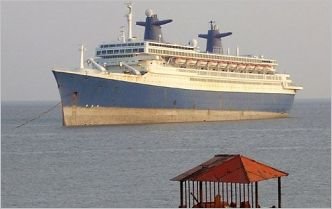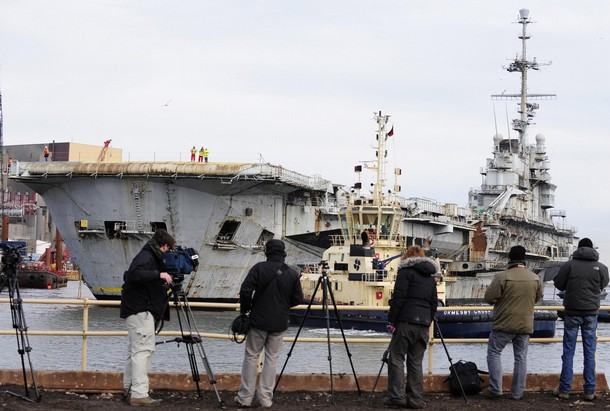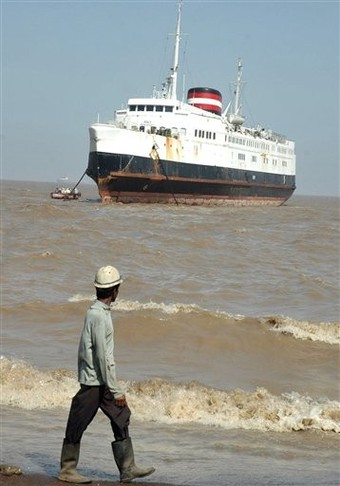Note: Is it a coincidence that Alang beach in India, Chittagong beach in Bangladesh and Gadani beach in Pakistan on the Bay of Bengal have become the dustbin of the shipping companies of the industrialized countries from EU, Japan, US and others. A EU report on Ship breaking in South Asia refers to Alang and Sosiya on the west coast in the State of Gujarat, India; Chittagong on the shores of Sitakund on Bay of Bengal, Bangladesh; and Gadani in Karachi, Pakistan as "the ideal ship breaking location" unmindful of the fragile coastal environment. This report appears quite insensitive to the historical context in which hazardous industries and end-of-life products (wastes) are transferred to South Asian countries.
ToxicsWatch Alliance (TWA) disagrees with most of the motivated observations mentioned in the report based on its field visit with a UN team. The yards on beach are always in a mess. Contrary to the observations in the report that "Asbestos was packed separately in plastic bags and stored near a garbage collection point", the fact is asbestos is never found in isolation, it is always embedded in some other structure. The landfill at Alang is completely filled up. TWA disapproves of Japanese, EU, International Chamber of Shipping and IMO's myopic approach of financing or recommending such landfills ad infinitum.
EU's motivated interest in South Asian beaches results from the fact that some 40 per cent of ships/vessels demolished are under European flags or belonged to ship owners established in the European Union or to members of the European Free Trade Association.
It may be recalled that the first ship breaking activity in undivided India was reported near Garden Reach, Kolkata in 1912. In post-divided India, first vessel MV Kota Tenjong was beached at Alang beach for ship breaking purpose in 1983. There is a need to examine the circumstances of such hazardous, dirty and degrading activity which makes Alang beach, Chittagong beach and Gadani beach, the most polluted beaches in the world even as the beaches of the ship owning countries are protected and cherished by them. Such manifest double standards are unacceptable.
The fact is Alang Beach, Chittagong Beach and Gadani Beach are competing with each other to get themselves contaminated beyond remediation for short-sighted financial gains without comprehending the motives of ship owning companies and countries.
Gopal Krishna
ToxicsWatch Alliance (TWA)
Alang faces tough competition as Bangladesh yards resume work
Business at Alang’s ship-breaking yards plummeted by half in April as rival facilities in Bangladesh reopened after a 10-month closure ordered by the courts there over environmental concerns.
This is the sharpest month-on-month fall in two years at Alang, near the Gujarat town of Bhavnagar and home to Asia’s largest ship-breaking facility.
“The fall is due to competition from Bangladesh, which resumed ship-breaking operations at around 60 of its 110 ship-breaking slots from April after getting conditional permission from a Bangladesh court, which had banned ship-breaking activity for almost 10 months on environmental issues,” said a port official at Alang on condition of anonymity, as he was not authorized to speak to the media.
Alang received 20 ships with a tonnage of 139,596 in April compared with 34 ships and 302,356 tonnes in March.
“The fall in tonnage and ship arrival in April is the sharpest in the last one year. The fall is also the sharpest if compared with April last year,” said Vishnu Gupta, president, Ship Recycling Industries Association India (SRIA). “This is mainly due to competition from Bangladesh, which has started buying ships aggressively.”
This may be the beginning of a slow growth cycle for the Indian ship-breaking industry as the situation is likely to worsen in the next few months.
“We are offering around $500 (Rs.22,650) per tonne rates to sellers while Bangladeshi recyclers are offering more than $520 per tonne as they want to make up for lost business, which is why most sellers are preferring Bangladesh over India,” explained an Alang-based recycler who did not want to be named.
He said Indian ship-breakers cannot afford to buy ships at higher prices as they mostly sell their scrap steel in the domestic market, where there is a disparity in the prices between ship-buying rates and scrap steel rates.
“We are buying ships at around $500 per tonne while scrap steel prices are at Rs.23,000 ($507) per tonne. We are losing our business to Bangladesh as they can afford to buy ships at higher rates because of lower labour costs,” the ship-breaker said.
Indian ship breakers have seen profit margins shrink, said SRIA vice-president Vippin Agrawal. He didn’t elaborate on the extent of this shrinkage.
The neighbouring nation is also attracting companies that intend to scrap larger vessels, which is a concern for Indian ship-breakers.
“Bangladesh has bought dozens of ships in the last one-and-a-half months and is in final negotiations with two international firms willing to scrap two VLCCs (very large crude carriers that weigh 200,000-320,000 tonnes each),” said a ship-breaker at Alang, also requesting anonymity.
Email and phone calls to Hefazatur Rahman, president of the Bangladesh Ship Breakers Association, did not elicit any response.
“We are already facing problems of smaller ships coming for dismantling for the last one year. Competition from Bangladesh has added to it,” said SRIA’s Gupta.
In 2010-11, Alang scrapped 357 vessels against 348 vessels in 2009-10. However, tonnage at Alang’s 173 slots fell to 2.8 million tonnes (mt) from about 2.96 mt in 2009-10, the highest in 12 years, Gupta said. The fall in tonnage despite more vessels is because of their smaller sizes, he said.
Alang’s ship-breakers have cancelled plans to hire more workers, Gupta said.
“In 2009-10, when the industry was faring well, we were planning to raise the workforce to 25,000 from the current 15,000. That plan has been cancelled. If the situation doesn’t improve in the coming months then we may be forced to reduce the workforce,” Gupta said.
http://www.livemint.com/2011/05/26215625/Alang-faces-tough-competition.html?atype=tp
This group tracks the responses of shipping industry towards environmental and occupational health justice, highlights influence of shipping companies from EU, US and Japan etc. on IMO, its Marine Environment Protection Committee and South Asian governments. It is keen to restore beaches in India, Bangladesh and Pakistan to their pristine glory for the coming generations. For more information visit: www.toxicswatch.org
28/05/2011
Economics of End-of Life Ships
THE ECONOMICS OF SHIP DISMANTLING, SHIP BREAKING AND SHIP RECYCLING
Why Ship-owners Sell Ships for Ship dismantling, shipbreaking and ship
recycling?
When the maintenance costs of the vessel start to exceed possible
revenue, or when the vessel has become unattractive for the second-hand
market.
How Ships are sold for Ship dismantling, ship breaking and ship
recycling?
Ship-owners who have decided to end the economic life of a vessel will
look for a cash buyer. The cash buyer will either be a dedicated broker
or the scrap yard operator himself. Typically, the ship will take cargo
for a final voyage to the area where the scrap yard is located. After
completion of this voyage, the ship will be brought, under its own
power, to the scrap yard where it will be dismantled. The cash buyer
pays a price in US$ per light displacement ton (ldt), which is roughly
equivalent to the steel weight of the ship.
What is normal price at Ships are sold?
For years the price has been around 150 US$/ldt (with lows around 100
US$/ldt and highs around 200 US$/ldt), but recently the strong demand
for steel scrap in China and the low supply of ships have driven prices
up to record levels of nearly 500 US$/ldt for average vessels and more
for particularly valuable ones.
What affects Ship Breaking Industry Most?
Freight market, the number of ships available for scrapping depends on
conditions on the freight market. If ships can still earn good money,
owners will not decide to send the ship for scrapping. In the past two
years, scrapping volumes were very low due to a booming and profitable
freight market.
The large majority of ships for scrapping will have to come from the
deep sea merchant fleet and will be mainly tankers and bulk carriers
(which are the “volume” segments). Other market segments, such as
warships, inland waterways vessels and offshore structures, are of
limited size and availability and so can hardly provide a steady stream
of material for large-scale recycling. The operator of a modern
recycling facility will therefore have difficulty building a business
model that fully covers its amortization costs.
What is life span of normal ship?
Ships are individual constructions with a long life-cycle and will have
undergone many repairs and maintenance in their 20-30 years of
operation. . The ships currently heading for the scrap yards were built
in the 1970s using materials that are no longer used today (e.g.
asbestos).
What is dismantling capacity in the EU?
There are facilities for larger ships mainly in Belgium, Italy and the
Netherlands, with a combined capacity of about 230,000 ldt/year, and a
multitude of smaller facilities for fishing vessels and other small
craft in most other maritime Member States. Taken together, the
existing capacity in the EU for ship dismantling may be estimated at
approximately 500,000 ldt per year. The EU neighbouring Turkey having
20 dismantling yards on the shore of Aliaga (near Izmir) have a joint
capacity of approximately 1 million tons per year. (As on 2007).
Source : http://scrapshipbreaking.com/2011/05/20/the-economics-of-ship-dismantling-ship-breaking-and-ship-recycling/
GADANI SHIP BREAKING YARD, PAKISTAN
Gadani ship-breaking yard is the world’s third largest ship breaking yard. The yard consists of 132 ship-breaking plots located across a 10 km long beachfront at Gadani, Pakistan, about 50 kilometres northwest of Karachi.
In the 1980s, Gadani was the largest ship-breaking yard in the world, with more than 30,000 direct employees. However, competition from newer facilities in Alang, India and Chittagong, Bangladesh resulted in a significant reduction in output, with Gadani, today, producing less than one fifth of the scrap it produced in the 1980s. The recent reduction in taxes on scrap metal has led to a modest resurgence of output at Gadani, which now employs around 6,000 workers.
In the 2009-2010 fiscal year, a record 107 ships, with a combined light displacement tonnage (LDT) of 852,022 tons, were broken at Gadani whereas in the previous 2008-2009 fiscal year, 86 ships, with a combined LDT of 778,598 tons, were turned into scrap.
http://scrapshipbreaking.com/2011/05/08/gadani-ship-breaking-yard-pakistan/
Why Ship-owners Sell Ships for Ship dismantling, shipbreaking and ship
recycling?
When the maintenance costs of the vessel start to exceed possible
revenue, or when the vessel has become unattractive for the second-hand
market.
How Ships are sold for Ship dismantling, ship breaking and ship
recycling?
Ship-owners who have decided to end the economic life of a vessel will
look for a cash buyer. The cash buyer will either be a dedicated broker
or the scrap yard operator himself. Typically, the ship will take cargo
for a final voyage to the area where the scrap yard is located. After
completion of this voyage, the ship will be brought, under its own
power, to the scrap yard where it will be dismantled. The cash buyer
pays a price in US$ per light displacement ton (ldt), which is roughly
equivalent to the steel weight of the ship.
What is normal price at Ships are sold?
For years the price has been around 150 US$/ldt (with lows around 100
US$/ldt and highs around 200 US$/ldt), but recently the strong demand
for steel scrap in China and the low supply of ships have driven prices
up to record levels of nearly 500 US$/ldt for average vessels and more
for particularly valuable ones.
What affects Ship Breaking Industry Most?
Freight market, the number of ships available for scrapping depends on
conditions on the freight market. If ships can still earn good money,
owners will not decide to send the ship for scrapping. In the past two
years, scrapping volumes were very low due to a booming and profitable
freight market.
The large majority of ships for scrapping will have to come from the
deep sea merchant fleet and will be mainly tankers and bulk carriers
(which are the “volume” segments). Other market segments, such as
warships, inland waterways vessels and offshore structures, are of
limited size and availability and so can hardly provide a steady stream
of material for large-scale recycling. The operator of a modern
recycling facility will therefore have difficulty building a business
model that fully covers its amortization costs.
What is life span of normal ship?
Ships are individual constructions with a long life-cycle and will have
undergone many repairs and maintenance in their 20-30 years of
operation. . The ships currently heading for the scrap yards were built
in the 1970s using materials that are no longer used today (e.g.
asbestos).
What is dismantling capacity in the EU?
There are facilities for larger ships mainly in Belgium, Italy and the
Netherlands, with a combined capacity of about 230,000 ldt/year, and a
multitude of smaller facilities for fishing vessels and other small
craft in most other maritime Member States. Taken together, the
existing capacity in the EU for ship dismantling may be estimated at
approximately 500,000 ldt per year. The EU neighbouring Turkey having
20 dismantling yards on the shore of Aliaga (near Izmir) have a joint
capacity of approximately 1 million tons per year. (As on 2007).
Source : http://scrapshipbreaking.com/2011/05/20/the-economics-of-ship-dismantling-ship-breaking-and-ship-recycling/
GADANI SHIP BREAKING YARD, PAKISTAN
Gadani ship-breaking yard is the world’s third largest ship breaking yard. The yard consists of 132 ship-breaking plots located across a 10 km long beachfront at Gadani, Pakistan, about 50 kilometres northwest of Karachi.
In the 1980s, Gadani was the largest ship-breaking yard in the world, with more than 30,000 direct employees. However, competition from newer facilities in Alang, India and Chittagong, Bangladesh resulted in a significant reduction in output, with Gadani, today, producing less than one fifth of the scrap it produced in the 1980s. The recent reduction in taxes on scrap metal has led to a modest resurgence of output at Gadani, which now employs around 6,000 workers.
In the 2009-2010 fiscal year, a record 107 ships, with a combined light displacement tonnage (LDT) of 852,022 tons, were broken at Gadani whereas in the previous 2008-2009 fiscal year, 86 ships, with a combined LDT of 778,598 tons, were turned into scrap.
http://scrapshipbreaking.com/2011/05/08/gadani-ship-breaking-yard-pakistan/
26/05/2011
Supreme Court Worried about Ship Dismatnling on Alang Beach
Note: Some 120 ships are currently standing on once pristine Alang beach. The hazardous industrial operations in this fragile coasatal environment began in the early eighties in the pre-Environment Protection Act, 1986 era. It is about time Alang beach taken away from the vice like grip of ship owning companies and countries and is restored to its earlier glory.
Danish companies have strong stake in ship-breaking in Alang, Gujarat and they pursue goal of dumping hazardous wastes by mutilating Basel Convention and by supporting International Maritime Organisation (IMO) Convention on Shipbreaking calling it recycling.
It may be recalled that the Danish ship “Ricky” (51 year-old asbestos laden ship, Kong Fredrick IX) contained hazardous wastes entered Alang beach for scrapping ilegally as it was bought by Jupiter Ship Management, a Mumbai based company. On 15 April, 2005, Connie Hedegaard, Denmark's environment minister alerted her Indian counterpart A Raja about the illegal movement of this ship. Ricky ('Kong Frederik IX') left Denmark on 16 March 2005. One wonders as to why did it take one month for the Danish Minister to alert the Indian auhtorties? What is the fate of the case that was filed against the original ship owner in Denmark? Letters were sento Danish authorties but no reply was recieved.
Per Stig Moller, the then Danish Minister of Foreign Affairs also wrote to K Natwar Singh, the then Indian Foreign Minister. This was followed-up by meetings between Michael Sternberg, the then Danish ambassador in Delhi and the Pradipto Gosh, the top bureaucrat and Secretary at the Indian Ministry of Environment and Forests (MoEF).
On 23 April 2005, "Riky" arrived for scrapping at Alang under the jurisdiction of Gujarat Maritime Board. Even the flag under which the ship sailed in isn't perfectly clear. N B Deshmukh, the then Assistant Commissioner, Customs Division, Bhavnagar, Gujarat said that Riky was carrying the flag of Democratic Peoples Republic of Korea (North Korea). An application was filed in 2005 challenging the MoEF in the Supreme Court on the ship's admission into India because the ship sailed in under the flag of Roxa, a non-existent "country". The case is till pending in the Supreme Court.
Ship owning countries and compnies are using IMO Convention to make such state of affairs legitimate. If that happens Alang will practically be deemed a place outside the jurisdiction of Government of India.
Is it wild to draw a possible link between India's best kept secret of the night when arms rained over Purulia in Bengal at night on 17th December, 1995 and Alang's ship breakers with business relations with Danish enterprises?
The next date of listing of the hazardous wastes case is 5th August, 2011.
Gopal Krishna
ToxicsWatch Alliance (TWA)
The Supreme Court bench of Justice G.S. Singhvi and Justice C.K. Prasad expressed concern over the environmental impact of dismantling and recycling of foreign ships carrying radioactive material and other toxic wastes at Alang port in Gujarat.
The apex court wished to know as to why these ships were not dismantled or broken in the country of their origin. Justice Singhvi said that tonnes of toxic waste was being brought to Alang port and dumped there.
The court said that recycling and breaking of ships at Alang port could be beneficial for some people in Gujarat or in other states but it was adversely impacting the environment.
"Why don't they break these ships in their own countries," Justice Singhvi asked.
The court made it clear that it would not be an indifferent spectator if there was any adverse bearing on the environment because of ship recycling activities. "If there is a threat to environment, then this court will intervene," said Justice Singhvi.
The court's observations came in the course of the hearing of a petition by Alang port-based Ship Recycling Association (India) seeking direction to Gujarat Maritime Board (GMB) not to go ahead with the auction of four plots each measuring 120 square metre.
The association asked the court to direct the board to first implement the recommendation of the committee of technical experts which said that smaller plots of 30 square metre each should be merged to create bigger plots as the smaller plots were not suitable for carrying out ship recycling activities.
The association told the court that the board accepted the recommendation of the committee and decided in favour of larger plots by phasing out the existing smaller plots.
The association sought orders restraining the board from auctioning the four plots without first merging the existing smaller plots to create bigger plots. The court declined the plea.
The court dismissed the application by the association.
The order dated 25/05/2011 by the (VACATION BENCH) is as under:
UPON hearing counsel the Court made the following
O R D E R
In this application filed by Ship Recycling Association (India), prayer has been made to restrain the Gujarat Maritime Board (for short, 'the Board') from auctioning the four vacant plots measuring 120 square meters at Alang Ship-Recycling Yard and to direct the Board to amalgamate and/or convert the existing smaller plots measuring 30 square meters into bigger plots before auctioning the four vacant plots.
While, learned counsel for the applicant heavily relied upon the recommendations made by the Standing Monitoring Committee on Ship Breaking Yard at Alang which is said to have recommended for merger of the available plots with the smaller plots, learned counsel representing the Board submitted that in view of the provisions contained in the Gujarat Maritime Board Act, 1981 (for short, "the Act"), the Gujarat Maritime Board (Conditions and Procedures for Granting Permission for Utilising Ship Recycling Plots) Regulations, 2006 (for short, "the Regulations") and the policy framed by the Board for amalgamation/merger of the existing plots, the smaller plots on which the members of the applicant association are carrying their operations, cannot be merged with the four plots proposed to be auctioned. Learned counsel also produced site map to show that the plots proposed to be auctioned are far away from the 30 square meters plots and argued that the same cannot be amalgamated or merged with the smaller plots.
We have considered the respective submissions and carefully perused the documents on which reliance has been placed by learned counsel for the parties. We have also gone through the provisions of the Act and the Regulations as also the guidelines framed by the Board for amalgamation of the plots.
In our view, the prayer made by the applicant is thoroughly misconceived and there is no valid ground, much less, justification for restraining the Board from auctioning the four plots or for issue of a direction for conversion of the existing smaller plots into bigger plots by adding portions of the four plots with the smaller plots. Although, there is some dispute between the parties about the exact distance between the smaller plots on which members of the applicant association are carrying their operations, they are ad idem that two kinds of plots are situated at some distance. The Regulations framed by the Board in exercise of the power conferred upon it under Sections 37, 38, 39, 41 and 110 of the Act and Clause-A of the guidelines do not permit for amalgamation of the plots by shifting the existing plots to another plot location.
The guidelines also prohibit amalgamation of two working plots. In terms of sub-clause (2) of Clause-A, the vacant plot located in between two working plots having 30 square meters width can be offered to both adjoining plot holders in equal measure. However, there is no provision for amalgamation of larger plots with the smaller plots irrespective of the distance between two plots. Therefore, there is no warrant for staying the auction of the four plots measuring 120 square meters or for issue of a direction to the Board to merge portions of the bigger plots with the smaller plots.
In the result, the application is dismissed.
Danish companies have strong stake in ship-breaking in Alang, Gujarat and they pursue goal of dumping hazardous wastes by mutilating Basel Convention and by supporting International Maritime Organisation (IMO) Convention on Shipbreaking calling it recycling.
It may be recalled that the Danish ship “Ricky” (51 year-old asbestos laden ship, Kong Fredrick IX) contained hazardous wastes entered Alang beach for scrapping ilegally as it was bought by Jupiter Ship Management, a Mumbai based company. On 15 April, 2005, Connie Hedegaard, Denmark's environment minister alerted her Indian counterpart A Raja about the illegal movement of this ship. Ricky ('Kong Frederik IX') left Denmark on 16 March 2005. One wonders as to why did it take one month for the Danish Minister to alert the Indian auhtorties? What is the fate of the case that was filed against the original ship owner in Denmark? Letters were sento Danish authorties but no reply was recieved.
Per Stig Moller, the then Danish Minister of Foreign Affairs also wrote to K Natwar Singh, the then Indian Foreign Minister. This was followed-up by meetings between Michael Sternberg, the then Danish ambassador in Delhi and the Pradipto Gosh, the top bureaucrat and Secretary at the Indian Ministry of Environment and Forests (MoEF).
On 23 April 2005, "Riky" arrived for scrapping at Alang under the jurisdiction of Gujarat Maritime Board. Even the flag under which the ship sailed in isn't perfectly clear. N B Deshmukh, the then Assistant Commissioner, Customs Division, Bhavnagar, Gujarat said that Riky was carrying the flag of Democratic Peoples Republic of Korea (North Korea). An application was filed in 2005 challenging the MoEF in the Supreme Court on the ship's admission into India because the ship sailed in under the flag of Roxa, a non-existent "country". The case is till pending in the Supreme Court.
Ship owning countries and compnies are using IMO Convention to make such state of affairs legitimate. If that happens Alang will practically be deemed a place outside the jurisdiction of Government of India.
Is it wild to draw a possible link between India's best kept secret of the night when arms rained over Purulia in Bengal at night on 17th December, 1995 and Alang's ship breakers with business relations with Danish enterprises?
The next date of listing of the hazardous wastes case is 5th August, 2011.
Gopal Krishna
ToxicsWatch Alliance (TWA)
The Supreme Court bench of Justice G.S. Singhvi and Justice C.K. Prasad expressed concern over the environmental impact of dismantling and recycling of foreign ships carrying radioactive material and other toxic wastes at Alang port in Gujarat.
The apex court wished to know as to why these ships were not dismantled or broken in the country of their origin. Justice Singhvi said that tonnes of toxic waste was being brought to Alang port and dumped there.
The court said that recycling and breaking of ships at Alang port could be beneficial for some people in Gujarat or in other states but it was adversely impacting the environment.
"Why don't they break these ships in their own countries," Justice Singhvi asked.
The court made it clear that it would not be an indifferent spectator if there was any adverse bearing on the environment because of ship recycling activities. "If there is a threat to environment, then this court will intervene," said Justice Singhvi.
The court's observations came in the course of the hearing of a petition by Alang port-based Ship Recycling Association (India) seeking direction to Gujarat Maritime Board (GMB) not to go ahead with the auction of four plots each measuring 120 square metre.
The association asked the court to direct the board to first implement the recommendation of the committee of technical experts which said that smaller plots of 30 square metre each should be merged to create bigger plots as the smaller plots were not suitable for carrying out ship recycling activities.
The association told the court that the board accepted the recommendation of the committee and decided in favour of larger plots by phasing out the existing smaller plots.
The association sought orders restraining the board from auctioning the four plots without first merging the existing smaller plots to create bigger plots. The court declined the plea.
The court dismissed the application by the association.
The order dated 25/05/2011 by the (VACATION BENCH) is as under:
UPON hearing counsel the Court made the following
O R D E R
In this application filed by Ship Recycling Association (India), prayer has been made to restrain the Gujarat Maritime Board (for short, 'the Board') from auctioning the four vacant plots measuring 120 square meters at Alang Ship-Recycling Yard and to direct the Board to amalgamate and/or convert the existing smaller plots measuring 30 square meters into bigger plots before auctioning the four vacant plots.
While, learned counsel for the applicant heavily relied upon the recommendations made by the Standing Monitoring Committee on Ship Breaking Yard at Alang which is said to have recommended for merger of the available plots with the smaller plots, learned counsel representing the Board submitted that in view of the provisions contained in the Gujarat Maritime Board Act, 1981 (for short, "the Act"), the Gujarat Maritime Board (Conditions and Procedures for Granting Permission for Utilising Ship Recycling Plots) Regulations, 2006 (for short, "the Regulations") and the policy framed by the Board for amalgamation/merger of the existing plots, the smaller plots on which the members of the applicant association are carrying their operations, cannot be merged with the four plots proposed to be auctioned. Learned counsel also produced site map to show that the plots proposed to be auctioned are far away from the 30 square meters plots and argued that the same cannot be amalgamated or merged with the smaller plots.
We have considered the respective submissions and carefully perused the documents on which reliance has been placed by learned counsel for the parties. We have also gone through the provisions of the Act and the Regulations as also the guidelines framed by the Board for amalgamation of the plots.
In our view, the prayer made by the applicant is thoroughly misconceived and there is no valid ground, much less, justification for restraining the Board from auctioning the four plots or for issue of a direction for conversion of the existing smaller plots into bigger plots by adding portions of the four plots with the smaller plots. Although, there is some dispute between the parties about the exact distance between the smaller plots on which members of the applicant association are carrying their operations, they are ad idem that two kinds of plots are situated at some distance. The Regulations framed by the Board in exercise of the power conferred upon it under Sections 37, 38, 39, 41 and 110 of the Act and Clause-A of the guidelines do not permit for amalgamation of the plots by shifting the existing plots to another plot location.
The guidelines also prohibit amalgamation of two working plots. In terms of sub-clause (2) of Clause-A, the vacant plot located in between two working plots having 30 square meters width can be offered to both adjoining plot holders in equal measure. However, there is no provision for amalgamation of larger plots with the smaller plots irrespective of the distance between two plots. Therefore, there is no warrant for staying the auction of the four plots measuring 120 square meters or for issue of a direction to the Board to merge portions of the bigger plots with the smaller plots.
In the result, the application is dismissed.
Subscribe to:
Posts (Atom)









